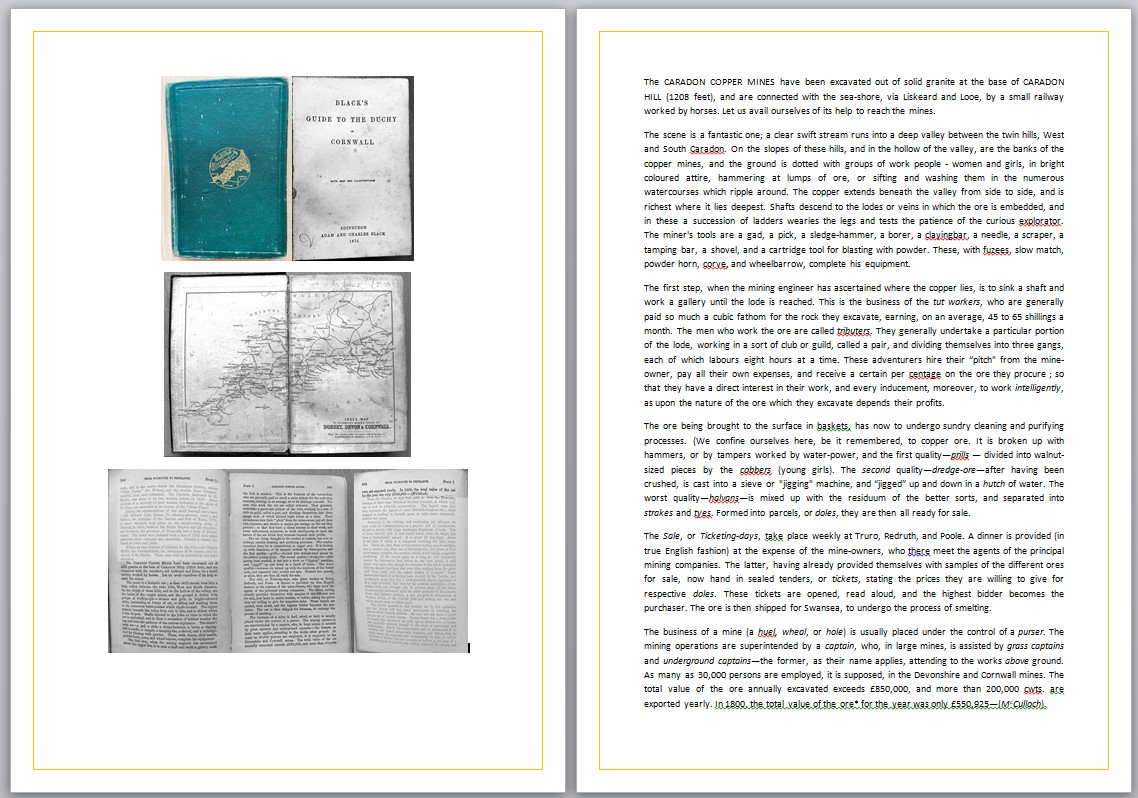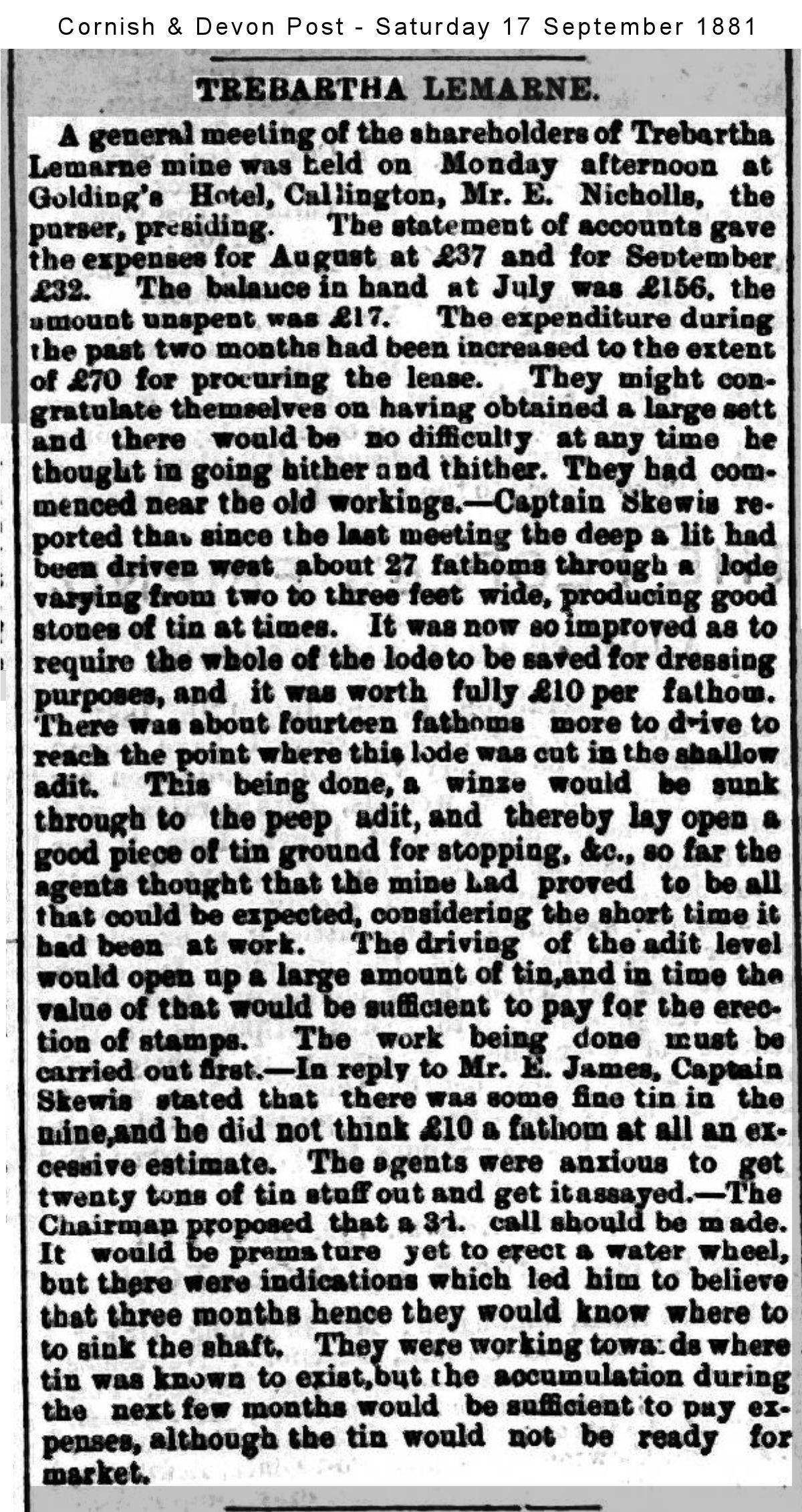


MINES |
Mines in the parish |
Quarries >> | ||

|
|||
A - Trebartha-Lemarne Mixed Mine |
B - Luskey Copper Mine |
C - Berriow Mixed Mine |
D - Hawkswood Mixed Mine |
E - Kingbear Mixed Mine |
F - Wheal Rodd Mine |
G - Great Rodd Mixed Mine |
H - Tremollet Mixed Mine |
J – Wheal Lanoy |
|||
Why are there minerals in our parish? |
|
300 million years ago a mass of molten rock pushed up from below the Earth’s crust, underneath what is now South West England. You can imagine the animation below is looking westwards from Dartmoor in the foreground to Bodmin Moor in the distance. You will see the molten rock break into the crust, cool down and suffer erosion to expose the granite uplands we see today. The animation looks into the future when the surface has been further eroded to show the single mass of granite (a batholith) that extends from Dartmoor and onto Bodmin Moor; from there it ranges down through the county to Land’s End and beyond. 
 Reproduced from https://projects.exeter.ac.uk/geomincentre/batholith.htm |
|
The minerals contained in the molten rocks and the surrounding rocks existed in a fluid state and seeped into veins and cracks in the rocks around the edge of the granite mass where they cooled into solid ores. As different minerals solidify at different temperatures the minerals of copper, lead, tin, wolfram and others can generally be found in discrete lodes. North Hill is in the area on the edge of the granite mass of Bodmin Moor where mineral cooling took place in the veins and cracks in the rocks and mines have been driven into the Earth to extract the precious ores. |
Mining Practices in the 1870s as described in "Black's Guide to Cornwall" (1876)
Click to open pdf |
A Treatise on The Copper Mines of Cornwall
Click to open pdf |
Trebartha-Lemarne Mixed Mine |
|
From Venning’s Postal Directory of 1901: |
 |
Wheal Fortune - North Hill's Lost Tin Streaming Operation |
|
|
There is a long history of extracting tin from Bodmin Moor and all the other moors of Cornwall and Devon. The earliest form of extraction was by streaming - back breaking work, like panning for gold, taking alluvial tin from the stream and river beds. The first written record of tin streaming dates back to the 12th century. Evidence of these early workings can be seen in most river valleys as heaps of rubble and waste which, in many cases, have become overgrown by grasses and bilberries. |
|
 | |
Very little is known about the streaming of tin in North Hill and in which rivers or streams these workings took place. The right to work the rivers and streams was granted by the ancient Stannary Courts and people invested in the various works with a view to taking a part of the profits based upon their investment. Such investors were known as adventurers and their money was provided to pay for the infrastructure of a streaming operation. As an example, one streaming works on the side of Tregonning Hill in West Cornwall was granted just 225 feet (almost 70 metres) on a stream but was a successful operation for some years. There are many mines of this name, "Fortune", throughout Cornwall but not all lived up to their name for the owners. In 1820 there was a dispute over the Wheal Fortune operaion in North Hill. This had been a works run by or invested in by a Mr Smith, a Mr Giles and others. Mr Smith had brought an action for some grievance against the others through the Stannary Court who decreed that 20 of the 64 shares were to be csold off. Anybody wishing to purchase any of these shares was invited to do so by this advertisement in the Royal Cornwall Gazette. A meeting to determine value of the shares was to take place in the Ring 0' Bells in North Hill. Nothing else is known about Wheal Fortune, just this advertisement. Do you have any knowledge of where this was or the nature of the dispute or what happened to the works? If you do, we'd love to hear from you and publish that knowledge here. | |
The banner image shows a cross section through the Trebartha-Lemarne Mine and Arthur Borlase, one time worker at Hawks Wood Mine who has recounted his memories in two parts - one and two. |